Off with their heads!
February can be such a busy month, just when it would be nice to relax and enjoy some summer weather. If I’m not dragging the hose around every second day, there is so much picking, plucking and pruning required to keep the garden looking and producing at its best.
The first phase of summer flowers have finished so deadheading is an important job to keep the plants looking good and save them the effort of producing needless seed.
I only have two roses, both in pots, so deadheading these is easy and rewarding. My rule of thumb is to prune back to the first 5-leaflet leaf (if you get my drift) where the strongest bud is. Regular deadheading encourages new flowering in a few weeks, but stop deadheading in April and let the hips and growth mature for the colder months.
Love them or loathe them, you won’t find agapanthus in my dream garden. The common agapanthus (A. orientalis) may have a place filling in hard to reach spaces, but they have a tendency to set a lot of seed which then germinate in unwanted places, and having such a strong root system, can be very hard to remove. My advice at this time of year is to chop off the heads before the seed pods dry and open.
The Renga Renga Lilies have finished flowering too and their stalks are dripping in seed pods. These can be a bit agapanthus-like in their desire to germinate so I chop the stalks off before the pods dry and open.
I normally leave the veggie garden writing to fellow columnist Sarah O’Neill but I have to tell you about my potato crop which challenges the theory of crop rotation. I have two small garden plots and one by virtue of its shape and size is just not suitable for growing rows of potatoes.
So every August to January for the last seven years I have grown potatoes in the same spot. And every year (with one exception) I’ve had a good return for my investment of seed, fertiliser, time and labour. They were planted with superphosphate and got hoed up a couple of times again with superphosphate. Early on, they were watered when necessary but not so much as they matured. This season has been the best yet with consistent yields from each root resulting in a good 27 kg from just two rows no more than 3 metres long. The varieties are Desiree (pink) and Heather (mauve).
So while crop rotation may be desirable, never let not being able to do it, put you off growing what you like.
One feature of the Desiree was the number of real potato fruit that formed after flowering. These fruit look like green tomatoes but don’t be tempted to eat them - they are full of the toxic chemical solanine.
My tomatoes, also grown in the same spot each year, are really late to ripen. I blame it on the gale winds and fickle temperatures of this summer. I give them a shake each morning to pollinate the flowers, and have trimmed off the lower leaves to allow more light to the fruit. There are plenty of them but they are still green.
Last year I lost my first tomato plants to blight, so this season I’ve sprayed every 3 to 4 weeks with Liquid Copper and they are lush and healthy.
No sign of the Tomato/Potato Psyllid either – that pest hasn’t found my garden yet and I’m hoping it never does – maybe the wind is good for something after all.
21-Feb-2014
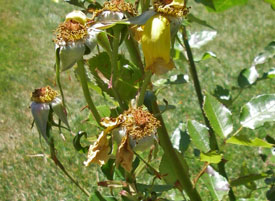
Roses waiting to be dead-headed
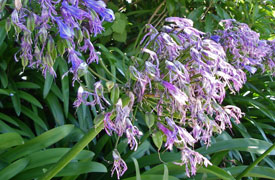
Agapanthus near seeding
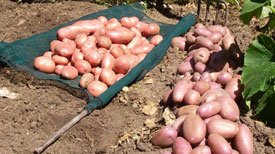
Potato Desire
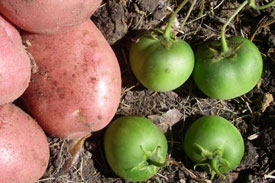
Potato Desiree young fruit
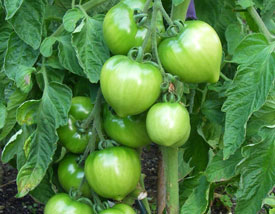
Green tomatoes

